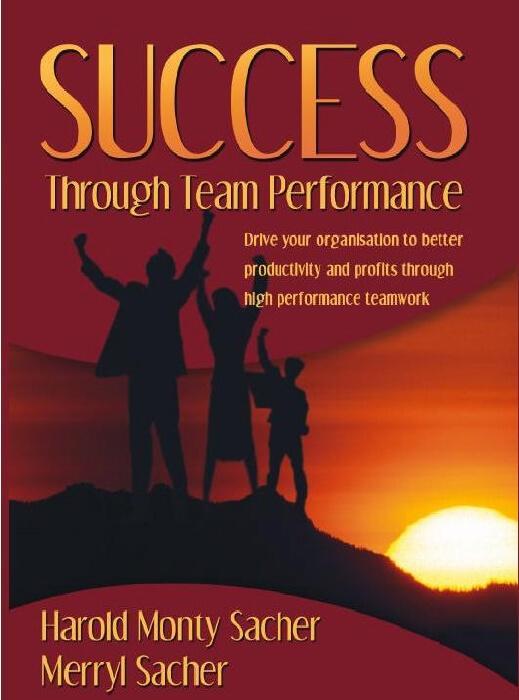
Success Through Team Performance
Publisher: Independent Pubs
Author: Harold Monty Sacher and Merryl Sacher
Format: Hardback
Pages: 290
Size: 200mm x 100mm
Released: 15 June 2005
Click here to view the EBook version
Success through Team Performance provides a system for developing and nurturing high performing teams. it addresses the basic building blocks, called the essential components of team performance and shows how to successfully implement them.
Success through Team Performance is based on practical and applied knowledge gained from years of hands-on experience in developing, implementing and anchoring team performance systems across cultures, countries and a wide range of industries. It has evolved from on-the-job work done by Sacher Associates, a productivity consulting group that applies basic performance systems in client companies to improve productivity and quality. Thousands of executives, managers, team leaders and employees attend workshops run by Sacher Associates to improve team and organizational performance.
The basic message of Success through Team Performance is that organisations must recognize the competitive advantages from playing as a team. They should understand the key to sustained success is for their people, working as a team, to improve continuously the delivery of value added outputs or services to customers and provide total stakeholder satisfaction. And with this realization, know how to put it into effect.This book shows you how to achieve this elusive goal.
With Success through Team Performance, Monty Sacher has produced a disciplined, systematic approach to developing teams that perform better now - and keep getting better. The book aims to isolate the basic principles evident in high performing teams and shows how they are practically applied. The goal is to satisfy any group of people who work together to produce a value-added end result.
It is presented in an easy-to-read format which has been used so successfully to translate business principles into clear, concise pathways for success.
Book content
The book is in three parts.
- Part One being an introduction to the basic components of team performance and why teamwork is important,
- Part Two covers the basic components of team performance comprehensively and forms the core of the book and
- Part Three is dedicated to guidelines for implementing a team performance system, the most common pitfalls, case studies and team models.
While each chapter can stand alone, together they form a comprehensive team performance system. Each chapter contains examples, summaries, checklists, glossaries and quality standards. This book consists of 12 chapters divided into three parts: Below is a summary of the contents:
Part 1: Preparation (consists of three chapters)
Introduction - Introduces the book and the authors.
Chapter One - The Big Picture provides a summary of the basic components of team performance. These are the basic components necessary to improve performance: individual performance, team performance and organisational performance. The aim is to implement these basics so as to build successful, high-performance teams. This chapter also clarifies the scope of the book.
Chapter Two - Why Develop Teams? addresses the impetuses driving the implementation of organisational teams, namely, the inability of traditional organisation structures to meet current employee needs, a highly competitive market place and the need for organisations to provide total stakeholder satisfaction to survive and grow. The chapter discusses how the basic components of team performance can assist with the development of teams.
Part II: The Basic Components of Team Performance (consists of seven chapters). Chapters three to nine address each of the basic components of team performance. These chapters form the core of the book.
Chapter Three - A Unified Sense of Direction means the entire organisation, and all the teams and the individuals which make it up, are pulling in the same direction. The first step in the development of a team-based organisation is clarity, focus and agreement about the values, vision and mission of the organisation. This will focus the team on what is important, where it wants to be, and how it will get there.
Chapter Four - Role Clarification shows how to identify the customers and stakeholders in order to help define and clarify the roles of the various teams and individuals that make up an organisation. An essential step in achieving success through team performance is defining the team and clarifying both team and individual roles.
Chapter Five - Outputs, Measures and Targets shows how to define the team's roles, now that customers and stakeholders have been clarified. Customer needs and expectations are clarified by developing a set of team outputs, measures and targets.
Chapter Six - Performance-linked Communication focuses on communication from a performance point of view. It answers the question 'What communication skills, systems and processes are needed to improve performance, to improve the delivery of outputs to customers and stakeholders?' A successful communication system must have entrenched mechanisms for communicating, analysing and discussing performance feedback on the outputs produced for customers and stakeholders so as to continuously improve productivity, quality and team work.
Chapter Seven - Performance-linked Learning shows how to ensure the delivery of the right skills and knowledge, in the right place, at the right time. This is achieved by implementing an ongoing, purposeful performance-linked learning system that is an integral part of the continuous improvement system. The outcome - training focused on identified output and performance requirements.
Chapter Eight - Team-based Organisation Structures describes current organisational structures, stressing that there is no best structure, rather the best structure will best facilitate the meeting of the following criteria: support the strategy; accommodate the opportunities and threats in the internal and external environment; achieve autonomous outputs, measures and targets; and satisfy the current needs and values of all employees.
Chapter Nine - Rewarding Performance shows how to establish reward systems that satisfy the motivational needs of all employees, and result in measurable team and organisational performance improvement. The module addresses positive recognition systems and team-based financial reward systems, showing how to implement a system that rewards performance, not mediocrity.
Part III: Implementation (consists of two chapters)
Chapter Ten - Implementation: Guidelines and Pitfalls provides guidelines for implementation and pitfalls to avoid. This chapter is based on the experience gained and the lessons learned from years of hands-on implementation in the field.
Chapter Eleven - Case Studies and Team Models concludes the book with a selection of case studies written by Australian organisational teams that have implemented our processes as well as model examples of some of the basic components of team performance selected from live teams. Titles include:
- Creation of self-directed work teams in the wool processing industry
- Cultural change in the electricity industry
- Performance workshops in the mining industry
- The ideal corporate training department
- The ideal hauler (truck) maintenance system
- A Meals-on-Wheels team in local government
- Teamwork promotes a smooth flow
- Teamwork - the holy grail?
- Teamwork must contribute to outcomes
Related books
Success through team performance - EBook

